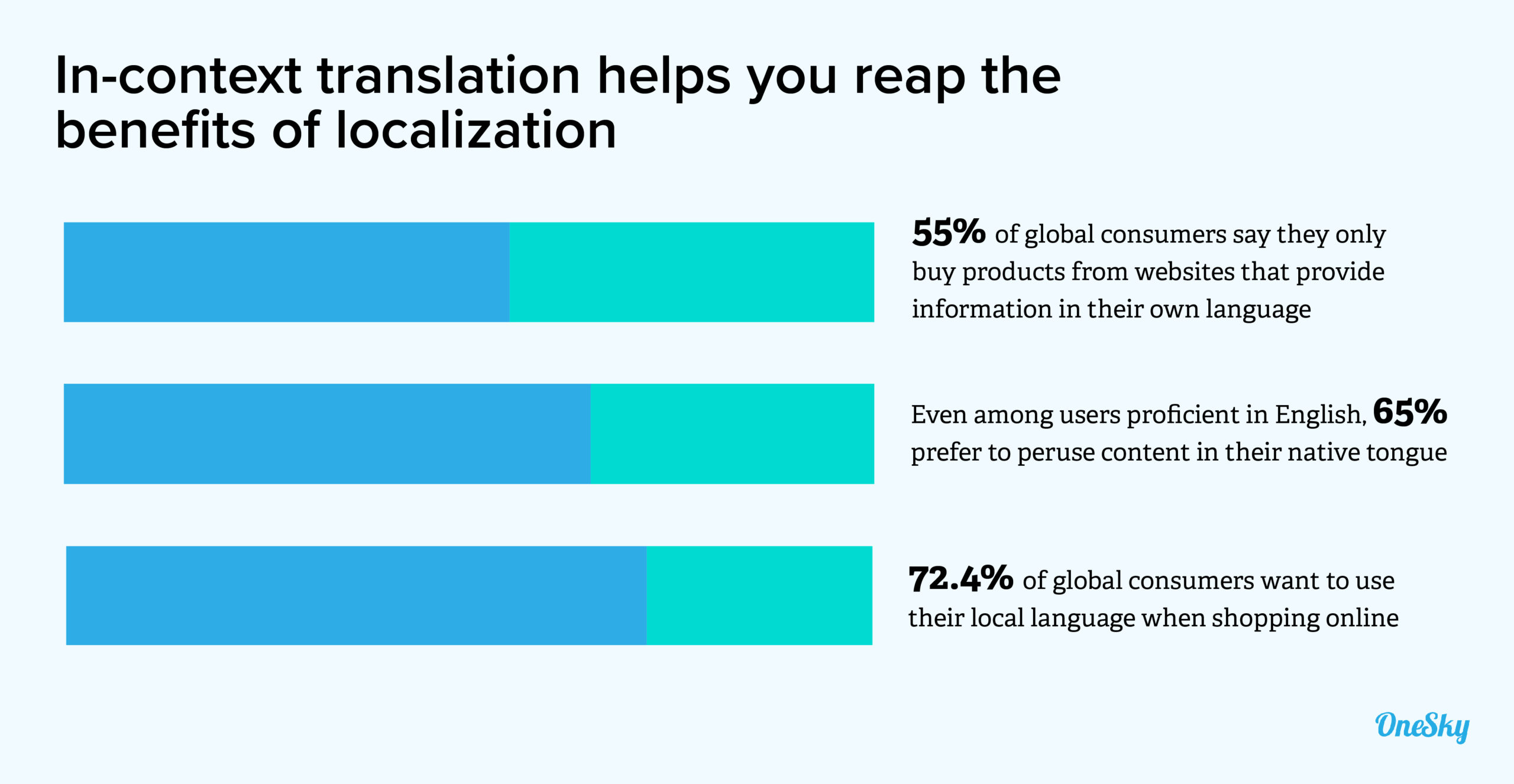In-Context Translation: A Key to Effective Localization
If your content works like gangbusters in your home market but falls flat on its face with a foreign markets, you may be missing out on this critical ingredient in your translation process—in-context translation.
You’re not alone.
Many brands make the mistake of using solutions that translate content in a vacuum. Yet, translation isn’t just about turning individual words from one language to another.
According to the Oxford Handbooks, translation conveys the meaning of a linguistic discourse from one language to another. It’s defined as the “sameness of meaning across languages.”

If the meaning or context of the original text gets lost in translation, the final content will fail to convey your message effectively.
Well-executed translation turns the core idea of a piece of text into a different language while preserving its tone, nuances, humor, references, etc., to communicate the same meaning or evoke a similar emotion.
What is In-Context Translation?
In-context translation addresses the environment in which a word or sentence is used. To avoid out-of-context translation, translators must understand the background of the original text. They need to decontextualize the original message, then recontextualize it in the target language.
The Importance of Context in Translation
Understanding the role of context in translation is key to successful localization. Context in translation gives the audience the frame to grasp the intention of a message. As such, it’s essential to creating high-quality localized content that resonates with your target audience.
Benefits of In-Context Translation
Addressing the role of context in translation not only helps ensure that your content is communicating its intended meaning. But it also allows you to connect with your target audience by using references, phrases, and concepts relevant to and resonate with them.
Acknowledging the role of culture and context in translation can help you fully reap the benefits of localization. These include expanding your market, gaining a competitive advantage, boosting your SEO, improving the customer experience, building trust with your audience, and increasing customer retention.
On the other hand, failure to address the context in translation can hurt your brand continuity, impact your credibility, and reduce the technical accuracy of the content. For example, poorly translated instruction in a software application can affect the user experience or even prevent your customers from getting the intended results.

Challenges of In-Context Translation
In localization projects, the text that requires translation is sent out in a file consisting of individual strings, which are removed from the context in which they’re used.
This is a necessary step in the localization workflow. It ensures that developers can incorporate translated text into a localized version of a product or website cost-efficiently.
However, without understanding how the audience should perceive and interact with the content, translators often have to make a guess and hope for the best.
The translated text may fail to communicate the original intent of the content; it may alter the meaning of a sentence; it may be too long and break the layout of the user interface. Or worse, it may be inappropriate and damage your brand image.
If the development team or local consultants catch the issue and send the translation back for revisions, your project will be delayed, and the cost will go up.
But if a mistake falls through the cracks—for example, your website goes live with a broken interface, your software launches with poor instructions, or your marketing materials make inappropriate references—your brand image and conversion rates could suffer.
The good news is that translators don’t need to be working in the dark.
How To Provide Context in Translation
You can shine a light on context by using different tools to illustrate the intended meaning and usage of the original message. Here are the three most common types of context and how you can apply them to achieve accurate and high-quality localized content:
Visual Context
By showing translators how the final content will appear visually (e.g., how it’s displayed on a webpage, app, or video game,) you can help them understand how users will interact with the information.
Doing so also helps translators understand how the final text may impact the user interface. For example, a direct translation of a call-to-action may be too long for the button graphic.

You can provide screenshots of the user interface to show translators how the final copy works in context. This can help eliminate back-and-forths between the translation and development teams to shorten the development cycle and speed up time to market without compromising the customer experience.
You can also use a WYSIWYG (what you see is what you get) tool that allows translators to translate, edit, and review the content directly on the final layout to ensure that the translated content fits the localized version of the website, app, software, or game.
Linguistic Context
Linguistic assets, such as a translation style guide and glossaries, help translators understand your brand’s key terms, localization strategy, brand voice, and target audience to identify the appropriate word choices.
Providing linguistic context is particularly important if you outsource translation tasks or have multiple translators working on a project. Linguistic assets help communicate the nuances of your brand to ensure a consistent tone. It takes the guesswork out of the translation process so translators can deliver more accurate translations in less time.
Upload a translation style guide to a localization platform, which offers a centralized location for all your assets so translators can access the latest information at any time and from anywhere. You can also use localization software with a translation memory feature to help improve the consistency and accuracy of your translation.
You should also include quality assurance as part of your localization workflow and have local linguistic experts review the final content to ensure they’re appropriate for the local market.
Situational Context
Delivering the right message to the right people at the right time and in the right place is key to driving conversions. As such, translators must understand how and why a message is delivered to your audience so they can pull the right triggers.
Provide translators with information about your audience, such as demographic data, interests, preferences, cultural background, and purchasing journey. You may also include context about your product, such as the storyline and biographies of the main characters in a video game.
Understanding the situational context helps translators connect the dots. This is essential for delivering a coherent experience across different touchpoints so you can effectively leverage an omnichannel strategy to facilitate conversions.
Hire translators who are native speakers and live in the locale where you’re launching your product. Ideally, they should be familiar with your industry—e.g., translators who are avid gamers can use terms and phrases that resonate with the local gaming community.
Reap the Benefits of In-Context Translation Without the Headache
Providing context to your translators helps them produce accurate and high-quality translated content cost-efficiently for your localization projects.
However, it can be challenging to coordinate the assets and manage the complex localization workflows to ensure that translators get all the information they need to gain a 360-degree view of your project, the audience, and the context.
The good news is that you don’t have to cobble together a dozen tools to get the job done.
Using a robust localization platform can help you coordinate all the assets and moving pieces. For example, translators can see screenshots, review background information, and access the latest translation style guide before diving in.
OneSky is an end-to-end solution that helps you manage localization projects in 50+ languages with access to 1000+ translators, so you can keep everything in one place to streamline workflow and ensure consistent and high-quality translation for every locale. Let us manage your mobile app localization process (via iOS app localization or Android app localization) or even your video game localization process.
Try OneSky for free and see how we can help you add context to your content without the headache.



 Written by -
Written by - 




 Written by
Written by 


